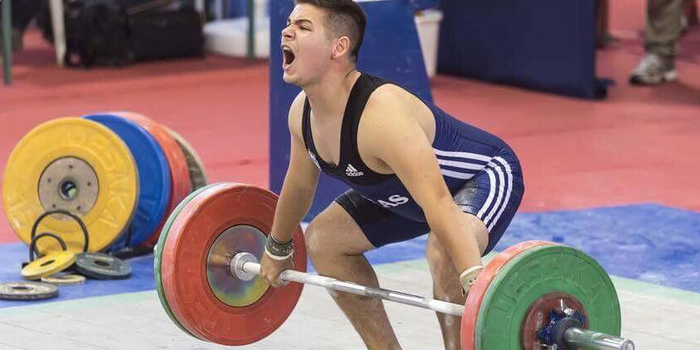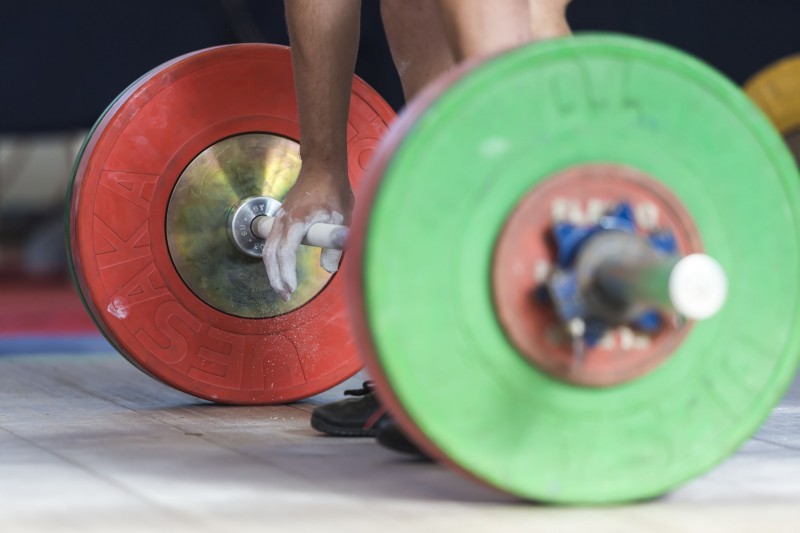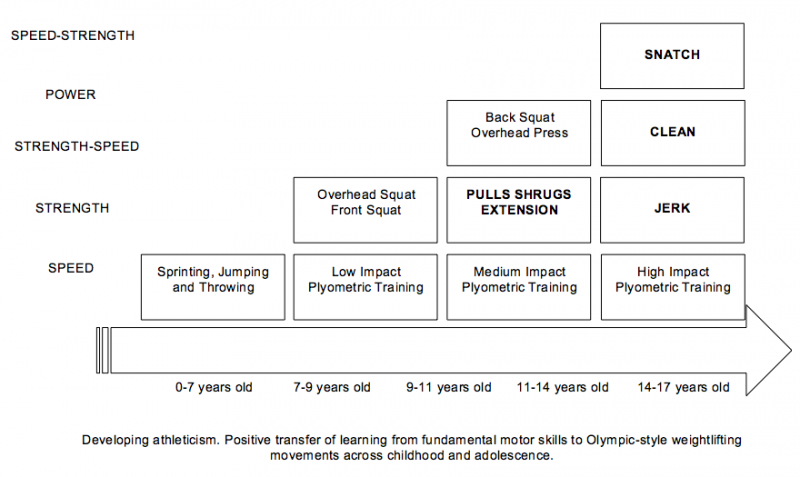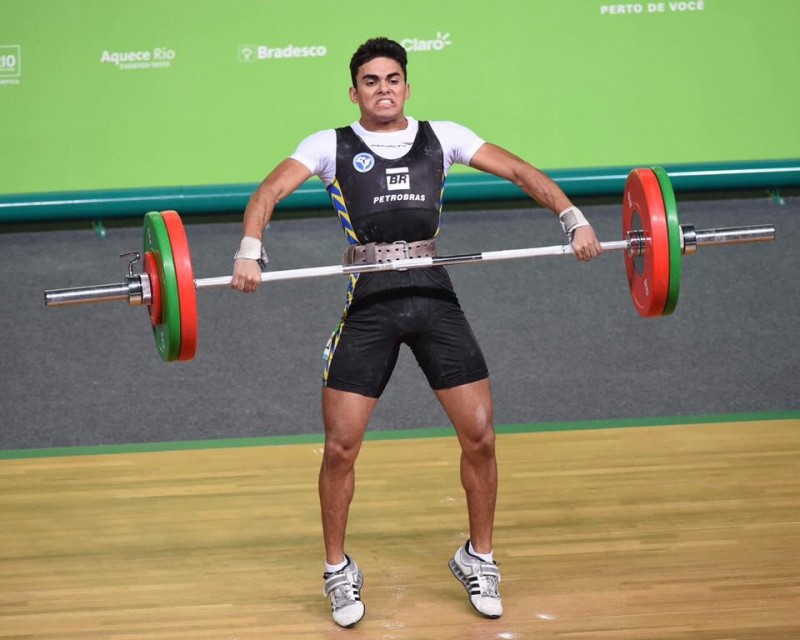
"The clean is a very important movement, both for motor skill development and for full-body conditioning. Learning it is important, since it is complicated, and learning complicated things improves the ability to learn." — Mark Rippetoe
Gaining the ability to learn new motor skills does represent a fundamental stage in the development of young athletes. Male and female athletes between the ages of seven and 11 years old become capable of developing more complex and coordinated movements by rationally assembling fundamental motor patterns into more sophisticated skills. Today we consider this carryover between fundamental and sport-specific skills as the most elementary example of transfer of learning, a concept somehow anticipated by Jean Piaget, who depicted this stage along the process of physiological growth and maturation as the concrete operational stage — the common ground for functional motricity to emerge.
RECENT: The Validity of Olympic-Style Weightlifting Exercises for Athletes
Learning new skills, such as snatching, cleaning, or jerking, requires a certain amount of time, effort and, most of all, repetitions. It is, to a certain extent, time-consuming. Repetitions are required to create a stable and reliable motor pattern, or a scheme of actions organized within the motor cortex to select, coordinate, and direct movements. The scheme described by Piaget is the main aspect of the assimilation process that leads to the acquisition of new skills during childhood and adolescence. On a larger scale, this is nothing but the general motor pattern theory first proposed by Schmidt in 1981; once the central nervous system (CNS) defines the basic, invariable aspects of the movement (timing, coordination, and kinesthetic differentiation), the cerebellum can incorporate speed and power to perform the lift as needed to train and compete. Lifting weight or throwing a football, in terms of motor learning and control, does not really make any difference.
So why are Olympic-style weightlifting exercises mostly neglected when it comes to young athletes? The misconception comes from a fundamental lack of understanding of the intimate relationship between muscular strength and speed. It comes, also, from a general lack of understanding of the physiological development of these physical attributes across childhood and adolescence.
If we abide to Schmidt's original theory, we would realize that strength (absolute strength) only represents a collateral aspect of learning new movements. When it comes to power development, this basic yet sometimes neglected aspect of movement theory does provide the key for a more profound interpretation of the actual limitations of children and teenagers. Peak power output can be achieved with different combinations of force (strength) and velocity (speed), as explained by Vivian Archibald Hill almost a century ago. This means that for any given level of muscular strength, new motor skills can be learned and executed efficiently just by moving faster. Olympic-style weightlifting exercises—pound for pound the most powerful movements that can be performed in a weight room—do represent, therefore, a very efficient way of teaching young athletes how to overcome inertia with speed.
Image Credit: VASILIS VERVERIDIS © 123RF.com
The ability to acquire new motor skills starting from basic movement patterns peaks during the first decade of life, representing the foundation of what is known as physical legacy or athleticism. It is before the onset of puberty that athletes acquire the fundamental motor skills needed to compete in sport. The golden age of motor learning—Piaget’s formal operational stage, the circa-pubertal phase that immediately precedes and follow peak height velocity (PHV)—represents, therefore, the most appropriate time to introduce young and pre-adolescent athletes to new motor skills.
Once again, performing a kip at the parallel bars or snatching 120 kilogram overhead does not really make a difference, since it is the learning process that matters. Growth and maturation foster the natural acquisition of those fundamental motor patterns that later in life will provide the building blocks for sport-specific skills to emerge. Olympic-style weightlifting has been shown to display mechanical features that are common to the vast majority of athletic movement involving running, sprinting, and changing direction, as well as jumping and landing, throwing and catching. These are mechanical features that increase the likelihood for young and pre-adolescent athletes to proficiently learn and master the snatch, the clean and jerk, and their derivatives by positively carrying over fundamental skills acquired earlier in life and consolidate through years of deliberate play.
Sophisticated in nature, Olympic-style weightlifting exercises require a great deal of coordination, balance, rhythm and overall sense of body awareness. Their technicality, however, should not discourage youth athletes from learning how to snatch, clean, and jerk efficiently.
It is important to remember how different, and apparently easier, sport-specific skills such as pitching a baseball or throwing a javelin, are rarely learned ex novo. They are rather built from scratch; the CNS digs into a basic cluster of motor skills such as sprinting, jumping, landing, throwing, and catching (just to name a few), looking for similarities to use as blocks to create a new motor pattern, never seen before. This is, in essence, the main idea behind the transfer-appropriate processing approach (TAP) theory, a theory developed in sports physiology to explain transfer of learning. Based on the fundamental axioms supporting this theory, by selecting specific exercises that share similar biomechanical features with the most common Olympic-style weightlifting exercises, it is possible to simplify the learning process required to master the snatch, the clean and jerk, and their many derivatives, while improving physical attributes such as speed and strength.
Propaedeutic exercises based on a series of fundamental motor skills such as squatting and jumping can, therefore, be incorporated in a well-assorted, well-rounded strength training program with the intention of building proper lifting mechanics from scratch before introducing Olympic-style weightlifting derivatives such as pulls, shrugs, and extensions. Explosive in nature, Olympic-style weightlifting exercises display important similarities to a broad variety of sport-specific skills that ultimately require force to be exerted against the ground in a vertical, linear way. By preserving these similarities while progressing in a simple to complex, analytic to global way, it is possible to teach young athletes how to snatch, clean, and jerk while fostering the development of general athleticism.
As children approach puberty, however, positive transfer of training (the development of strength-speed, the athletic-like expression of absolute strength in sport) takes over positive transfer of learning, as specialization in sport asks for a more remarkable development of physical attributes such as speed, power, and agility.
Ages 9 to 11
According to Johnson A. Barbara from Shriners Hospitals for Children in Salt Lake City, Utah, plyometrics represent the most natural form of physical activity during childhood and early adolescence. Jumping, landing, and skippingm as well as bouncing, hopping, and leaping, are basic motor pattern that emerge across the first decade of life, supporting the development of fundamental motor skills. Squat jumps and countermovement vertical jumps represent, therefore, excellent exercises when it comes to teaching young athletes how to create speed while exerting force against the ground.
Ballistic in nature, these movements improve the fundamental mechanics of power development (Verkhoshansky and Siff in the book Supertraining refer to plyometrics as "power-metrics", the physiological and mechanical blueprint of athleticism). The triple extension of hips, knees, and ankles is the blueprint of a broad variety of sport-specific skills, including Olympic weightlifting. Overhead squats and front squats can also be introduced during this early developmental stage in the effort to preserve the mobility necessary to perform snatch and clean and jerk (mobility is, not surprisingly, the limiting factor in learning Olympic-style weightlifting movements in adolescent male and female athletes), while developing overall strength and coordination. If properly trained, according to Keine, male and female athletes of 11 years old are capable of squatting up to their bodyweight.
Age 11 to 14
The "power clean", the most common Olympic-style weightlifting exercise performed by high school and collegiate athletes, can be seen, according to Mark Rippetoe, as “a jump with the bar in the hands." Olympic-style weightlifting derivatives such as pulls, shrugs, and extension represent, therefore, the best way to bridge the gap between basic motor patterns, such as jumping and squatting, and proper pulling mechanics — the fundamental aspect in learning how to snatch and clean using a barbell. Evidence in the most recent academic literature has shown how peak power output does not necessarily decrease during the execution of partial movements such as pulls, shrugs, and extensions.
This finding further supports the importance of using Olympic-style weightlifting derivatives to improve rate of force development, especially among young athletes approaching puberty. The circa-pubertal phase is also a time of intense physical development and it offers a significant opportunity to improve absolute strength. Between the ages of 11 and 14, male and female athletes undergo a period of intense ponderal growth; if properly trained, according to Keine, by the age of 14 youth athletes are capable of squatting up to 1.5 times their bodyweight. It is therefore fundamental during this intermediate stage to implement back squats and overhead presses, which are movements that teach athletes how to transfer force from the ground while developing the musculature of the lower and upper body.
Image courtesy of Ververidis Vasilis
Age 14 to 17
Muscular strength significantly improves throughout adolescence. According to Keiner, by the age of 17 male and female athletes are capable of squatting up to twice their bodyweight, sprinting 100 meters in 10 to 12 seconds, and jumping approximately 24 to 28 inches off the ground. Athletes are now strong enough to snatch, clean, and jerk. The “learning” aspect of any progression, from now on, becomes secondary, while improving performance become imperative. A growing body of evidence collected over the course of the last decade—since the Olympic-style weightlifting exercises have become more popular among high school and collegiate athletes—has shown a strong, positive correlation between performance in the snatch, clean and jerk, and linear speed, power, and agility among male and female athletes age 15 years and older.
According to Dr. Avery D. Faigenbaum from the Department of Health and Exercise Science at the College of New Jersey, by the age of 17 athletes should be able to clean and jerk 1.2 to 1.4 times their body weight and snatch 0.9 to 1.1 times their bodyweight. As strength comes more and more into play, Olympic-style weightlifting movements have been shown to produce the greatest peak power output of any resistance training exercise that can be performed in the weight room. It is imperative, however, to preserve optimal speed (bar speed) in order to further develop speed-strength, the most athletic-like expression of absolute strength.
Olympic-style weightlifting exercises and their many derivatives cover the entire spectrum of strength development along the force-velocity curve. Because of a longer bar path, snatching requires a greater amount of speed to be performed, whereas cleaning and jerking are thought to be strength-oriented movements. Explosive in nature, these exercises represent the most athletic-like form of resistance training. By implementing Olympic-style weightlifting exercises with more traditional forms of resistance training and plyometric drills, young and adolescent athletes can fully develop their potential, while further improving performance in sport. As strength improves, so does the ability to sprint faster, jump higher, and lift heavier weights overhead.
Antonio Squillante is the Director of Sports Performance and Training at Velocity Sports Performance, Los Angeles, California. He graduated summa cum laude from the University San Raffaele – Rome, Italy – with a Doctorate Degree in Exercise Science. Antonio has an unlimited interest in the field of sports biomechanics and long-term athletic development conducting academic research and presenting at national and international events as a member the International Society of Sports Biomechanics (ISBS) and the International Youth Conditioning Association (IYCA). He is a Certified Strength and Conditioning Specialist (NSCA-CSCS) and a member of the NSCA Advisory Board for the State of Pennsylvania and California. He is currently the Weightlifting Head Coach at California State University of Northridge (CSUN).
Header image courtesy of Ververidis Vasilis












